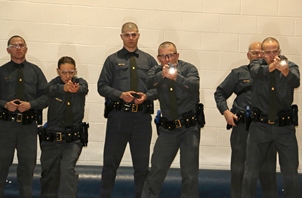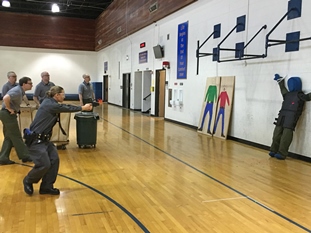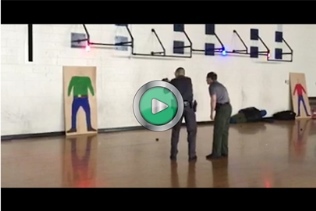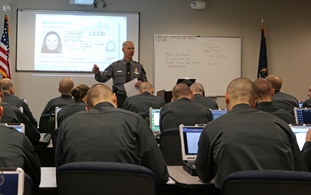Quick action deployment
Week 9: Feb. 28 – March 5
Momentum continued into week nine of the Department of Natural Resources conservation officer academy. The 20 returning recruits delved deeper into warrantless and warrant searches, cultural diversity training, Taser and emergency response situations. Although classroom instruction was still an important component of the very busy week, recruits also became immersed in a number of hands-on training and role-playing scenarios.
Warrantless searches
Monday and Friday mornings, the recruits focused on additional warrantless searches training, expanding on the previous week’s lessons. They learned about search warrant rules and exceptions to those rules and, during a limited number of circumstances, which types of warrantless searches are lawful.
Ensuring rights for all
Civil rights instruction followed, with the emphasis on ensuring all rights for all people.
“Conservation officers communicate with a broad user group – people enjoying the out-of-doors – and we need to treat everyone the same and act in a professional and courteous manner,” said Sgt. Jason Wicklund, recruit school commander.
After lunch, Sgt. Damon Owens and Conservation Officer (CO) Ivan Perez, who taught at the academy last week, returned to instruct cultural awareness and diversity training for the remainder of the afternoon. Sgt. Owens and CO Perez reinforced the importance of treating everyone professionally and with respect, and led role-playing scenarios where recruits practiced proper communication skills to overcome language barriers and appreciate cultural differences.
“Conservation officers are responsible for protecting Michigan’s natural resources and, at the same time, providing outreach to those who want to learn more about natural resources and the laws that protect these resources,” Sgt. Wicklund said. “We must be diligent in making sure that the people we communicate with know the laws and understand violations of these laws.”
More time in “the tank”
Tuesday morning, recruits were in the tank – the nickname given to the 12-foot pool – for morning physical training. As the recruits get closer to water safety week – five days focusing almost solely on water training – they continue to work on endurance, breathing techniques and extractions.
 “Conservation officers spend a considerable amount of time on or near water,” Sgt. Wicklund said. “The recruits need to understand that we may be called at any time to respond to a water-related emergency and need to have a working knowledge base and skill set to rescue others and, if ever needed, ourselves.” “Conservation officers spend a considerable amount of time on or near water,” Sgt. Wicklund said. “The recruits need to understand that we may be called at any time to respond to a water-related emergency and need to have a working knowledge base and skill set to rescue others and, if ever needed, ourselves.”
Tasers
After Tuesday morning PT, recruits shifted back to the classroom. They spent a full day focusing on survival tactics and, specifically, use of Tasers, electronic devices designed to propel two separate wires for direct contact, conducting energy to temporarily paralyze the sensory or motor functions of the nervous system.
In all, recruits will receive 20 hours of Taser training, eight of which took place Tuesday in the classroom. After they compete the necessary training, recruits will take a written and tactical exam, at which time they’ll be certified to use a Taser.
On Tuesday morning, they were issued Tasers, learned about each component of it, studied all related laws and applicable court opinions, and viewed a video on deploying a Taser. During the afternoon, the recruits were taught how to test, arm, reload and deploy the Taser utilizing several exercises and scenarios.
Searching for answers
 Wednesday morning, recruits took a short hiatus from the Taser to learn more about search warrant laws. Wednesday morning, recruits took a short hiatus from the Taser to learn more about search warrant laws.
“Search warrants are designed to do very specific things,” said Sgt. Wicklund. “They need to be written meticulously to cover all bases.”
Sgt. Wicklund noted, for example, that if a search warrant is issued and the officers are looking for an ORV, they would be limited to those areas where an ORV might be stored.
“It’s very important that recruits come out of search warrant training with a complete understanding of how search warrants work, including all applicable laws and a comprehensive understanding of how to write them.”
Becoming an expert on writing search warrants, however, takes time, Sgt. Wicklund said. Recruits will gain that expertise while serving Michigan’s citizens as conservation officers.
 Deploying Tasers Deploying Tasers
The remainder of Wednesday morning and all afternoon was spent in the gym during survival tactics training. Recruits practiced aiming and deploying their Tasers at stationary targets and reloading cartridges. View a video of one training exercise.
Responding to a “bar fight”
Recruits finished the afternoon participating in scenario training in the scenario room within the Michigan State Police training facility. The small room containing cushioning on all walls and the floor also was outfitted with foam furniture. Strobe lights, the only lighting in the room, and loud music helped set the scene – inside a bar. Recruits were walked to the room one at a time, at which point they were told that they were responding to an incident at a bar. The assailant, who was throwing furniture and glass bottles, was still inside. As each recruit entered the bar, an employee of the establishment yelled and pointed to the back of the room.
As the scenario unfolded, the assailant (played by a conservation officer outfitted in protective gear) aggressively approached the recruit, threatening harm. Those recruits who quickly and precisely deployed their Tasers at the assailant (who wore a Taser vest) and subdued and properly handcuffed him passed the exercise.
Emergency response training scenario
 At 6:30 p.m., recruits reported to the classroom. The men and woman soon learned they would be taking part in another training scenario. This time, they focused on Q.U.A.D. (quick action deployment), which they spent extensive time learning in the classroom last week. At 6:30 p.m., recruits reported to the classroom. The men and woman soon learned they would be taking part in another training scenario. This time, they focused on Q.U.A.D. (quick action deployment), which they spent extensive time learning in the classroom last week.
Q.U.A.D is a universal tactical plan used by law enforcement officers across the nation when responding to emergency situations such as mass shootings. Once a minimum of four officers respond to the scene, Q.U.A.D. can be deployed to locate and stop active shooters.
The training exercise, coordinated by the Michigan State Police (MSP) Emergency Response Team in conjunction with academy staff, simulated active shooters in the MSP training facility, which houses the recruits during the academy.
Recruits were organized into squads of four for multiple runs through the training exercise. As part of Q.U.A.D., each squad member has a specific function. Through multiple runs through the scenario, each recruit had the opportunity to serve in each position within the squad, learning the proper commands and responsibilities of each position.
“There are times when conservation officers will be part of Q.U.A.D. deployment, especially in rural areas where the number of law enforcement officers is limited,” Sgt. Wicklund said. “Conservation officers are trained through this program and available to serve in this capacity. At the end of the day, it’s all about saving lives.”
Citations
Warnings, citations and arrests classroom instruction started out the morning Thursday. The recruits were shown the DNR Law Enforcement Division’s uniform citation (ticket), and were taught how to properly fill it out.
 “The uniform citations we carry are very important,” Sgt. Wicklund said. “Prosecutors, judges, courts and the DNR use the information we provide on the tickets. We need to be accurate and precise when filling them out.” “The uniform citations we carry are very important,” Sgt. Wicklund said. “Prosecutors, judges, courts and the DNR use the information we provide on the tickets. We need to be accurate and precise when filling them out.”
The afternoon was spent on more Taser training in the gymnasium.
Vehicle searches
More laws on warrantless searches training encompassed Friday morning. After classroom time, the recruits reported outside for another training scenario to reinforce this very important instruction. This time, they were told to search portions of a vehicle, following proper laws and procedures for warrantless searches.
Although recruits were dismissed for the weekend, they were excited for the week to come. During week 10, they will be issued for the first time – and after a great deal of classroom instruction – their primary firearm, a Sig Sauer .40-caliber handgun. Then they’ll engage in their first of many firearm practices at the Michigan State Police shooting range.
Subscribe to the weekly conservation officer academy blog, which also is posted weekly on the Michigan DNR Facebook page. View past blogs from Recruit School No. 7.
# # #
/Photo details: Accompanying photos are available below for download. Caption information follows.
Taser training.jpg: Recruits practiced arming, activating and disarming their Tasers. They are also practicing loud, verbal commands prior to deploying.
Taser excercise.jpg: Recruits, one at a time, practiced deploying their Tasers at stationary targets while they were coached by Conservation Officer Academy staff.
QUAD scenario team.jpg: In squads of four, the recruits practiced Q.U.A.D – quick action deployment – during an evening scenario involving a simulated active shooter (training scenario only) within the facility. The blue handguns used by recruits during this and other training scenarios are not actual guns. They are props used for training.
Warnings, citations and arrests instruction.jpg: Instructed by Cpl. Mike Mshar, the recruits were shown the DNR Law Enforcement Division’s uniform citation (ticket) and were taught how to properly fill it out./
The Michigan Department of Natural Resources is committed to the conservation, protection, management, use and enjoyment of the state’s natural and cultural resources for current and future generations. For more information, go to www.michigan.gov/dnr.
|

 “Conservation officers spend a considerable amount of time on or near water,” Sgt. Wicklund said. “The recruits need to understand that we may be called at any time to respond to a water-related emergency and need to have a working knowledge base and skill set to rescue others and, if ever needed, ourselves.”
“Conservation officers spend a considerable amount of time on or near water,” Sgt. Wicklund said. “The recruits need to understand that we may be called at any time to respond to a water-related emergency and need to have a working knowledge base and skill set to rescue others and, if ever needed, ourselves.” Wednesday morning, recruits took a short hiatus from the Taser to learn more about search warrant laws.
Wednesday morning, recruits took a short hiatus from the Taser to learn more about search warrant laws.
 At 6:30 p.m., recruits reported to the classroom. The men and woman soon learned they would be taking part in another training scenario. This time, they focused on Q.U.A.D. (quick action deployment), which they spent extensive time learning in the classroom last week.
At 6:30 p.m., recruits reported to the classroom. The men and woman soon learned they would be taking part in another training scenario. This time, they focused on Q.U.A.D. (quick action deployment), which they spent extensive time learning in the classroom last week. “The uniform citations we carry are very important,” Sgt. Wicklund said. “Prosecutors, judges, courts and the DNR use the information we provide on the tickets. We need to be accurate and precise when filling them out.”
“The uniform citations we carry are very important,” Sgt. Wicklund said. “Prosecutors, judges, courts and the DNR use the information we provide on the tickets. We need to be accurate and precise when filling them out.”




